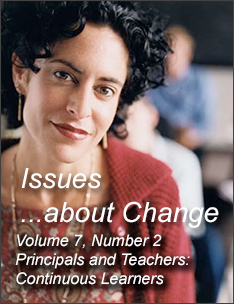Teachers Respond to Principals' Model
The teachers at these schools increasingly emulated the examples set by the principals. The principals demonstrated the meaning of professional learning community by constantly sharing their own learning with their staffs and by orchestrating opportunities for their staffs to incorporate the same practices. The staff members responded individually and as a whole to take on those practices. These principals valued the expertise that their teachers possessed and were able to tap it. The result was a staff that responded as professionals and willingly expanded their understanding of personal responsibility as teachers. In the process, the teachers came to value the PLC itself as they increased their effectiveness and tapped into their creativity.
We recognized the teachers' valuing of the PLC by the practices which they initiated on their own. These practices were reflected in specific themes that surfaced repeatedly as we studied the schools. Those themes included the following:
Looking for Ways to Improve Learning Conditions for Students
Just like their principals, these teachers were constantly learning about their profession. Some were reading. Some were attending workshops and conferences. All assumed that whatever they learned, they were responsible to bring it back to their colleagues at their schools.
Trusting Colleagues
The importance of relationships was clear in these schools. These teachers willingly put energy into their relationships with each other including the time to know about each other's personal lives. This was not invasive, nor gossipy, but had a sense of genuine caring about each other. That caring about each other translated to trusting each other professionally, which was critical to being able to work together as a whole staff. Individuals expressed confidence that actions taken and decisions made by committees would be in the best interest of the school as a whole, even when the individual was not part of that action or decision.
Asking Other Teachers for Advice
Teachers at these schools recognized other teachers for their expertise and actively sought counsel regarding particular students and classroom management as well as instruction. They readily exchanged information with each other and encouraged each other in their professional practice.
Taking Responsibility for the Operation of the School
As principals involved teachers in decision making the teachers increasingly identified decision making with their own professional duties. They came to expect to participate on committees and in study groups and understood that this work would lead to increased effectiveness of the school.
Valuing Team Work
Teachers could see that creativity and effectiveness were increased when they worked in groups. Although most of them found working in a group or team a little awkward or uncomfortable in the beginning, they came to prefer it once they had learned how to use the team approach effectively.
An interesting note is that these teachers did not show signs of "hiding behind the practices". In other words, they did not relinquish their individual styles nor did they use the practices to decrease personal responsibility. In fact, the reverse appeared to be true. They were affirmed in their individuality and the contribution that they made to the overall creativity of the group. They also expressed a willingness to work harder when they saw their colleagues actively pursuing a common goal. This is akin to the homeowner who re-landscapes her front yard to express her own aesthetic sense while remaining true to the expectations of the neighborhood where she has chosen to live. These teachers feel free to use their personal styles while their choices for instruction and participation in school operations reflect the identity that the whole school has chosen for itself.
Next Page: Concluding Thoughts

